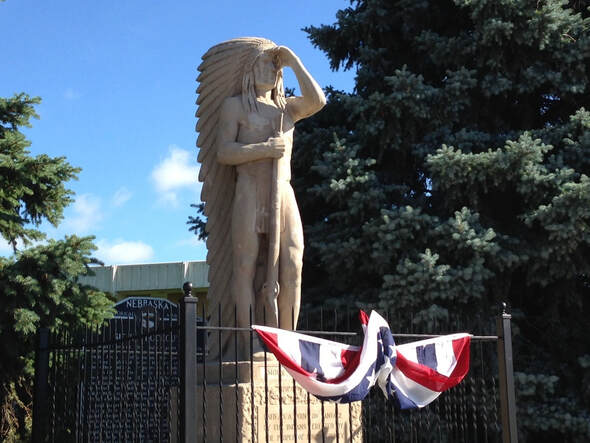North Platte, Nebraska
Chapter Officers
|
Regent
Molly O'Holleran Chaplain Laura Stewart Recording Secretary Mary Tanner |
Treasurer
Elizabeth Schanou Registrar Mary Agler Historian Patricia Frahm |
Sioux Lookout

DAR Sioux Lookout Chapter is named in honor of Sioux Lookout, an historic hill southeast of North Platte, which commands an unobstructed view of the Platte River Valley. The hill has historical significance. Its location on the highest point along the Platte River Valley helped promote community safety and development.
Pioneers used the Oregon and California trials to chase new land and gold. Trappers and traders came by 1813, the first wagon train in 1830, and first missionary in 1834. The Lakota Sioux used this point from1847 to 1880 as an observation place, spotting Oregon Trail travelers as they came up the valley. They defended against unfriendly Native American tribes and signaled friendly ones. From 1840 to 1865, over two and a half million people traveled the valley.
Between 1825 and 1892, 18 Nebraskan treaties between Native American tribes and the U.S. government made it legally possible for the United States to make land available to settlers. Life for American Indians on the Great Plains changed. The mid to late1800s brought increasing conflict with the white man for space, loss of their traditional lands, and the gradual destruction of their way of life.
Sioux Lookout hill overlooked Cottonwood Canyon, which later became Fort McPherson. The soldiers stationed there used the hill as a lookout for the approach of hostile Native Americans. Fort McPherson protected the Oregon Trail and the Transcontinental Telegraph Line, and continued to serve as protection against hostilities until after the Union Pacific Railroad was completed in 1869 and most trail travel ended.
Among the colorful characters associated with Fort McPherson is Buffalo Bill (William F. Cody), who headquartered there on several buffalo hunts. DAR Sioux Lookout Chapter has done extensive historical preservation of Buffalo Bill’s historic photos at Buffalo Bill Ranch National Historical Park, known as Scout's Rest Ranch. This living history state park and ranch was established in 1878. Cody promoted equity and access before his time. He paid all performers, (white men, American Indians, and women) in his “Buffalo Bill’s Wild West Show” the same salary. All who worked with him dined as family.
In 1931, craftsman Erwin Goeller created the Sioux Lookout statue commissioned by Lincoln County to commemorate the Oregon Trail. The statue was originally erected on Sioux Lookout ‘s historic hill. Unfortunately, decades of vandalism at that secluded spot took its toll. How do we preserve and honor history?
DAR recognizes the sacrifices, contributions, and achievements of Native Americans. The statue was removed and relocated behind wrought iron fencing at the Lincoln County Courthouse in downtown North Platte. It was renovated by DAR Sioux Lookout member and sculptor Mary Tanner in 2014. We continue to contact nearby reservations, museums, cultural groups, and schools to ask how we can further collaborate, strengthen, and empower American Indian communities.
~ by Sioux Lookout Regent Molly O’Holleran
Pioneers used the Oregon and California trials to chase new land and gold. Trappers and traders came by 1813, the first wagon train in 1830, and first missionary in 1834. The Lakota Sioux used this point from1847 to 1880 as an observation place, spotting Oregon Trail travelers as they came up the valley. They defended against unfriendly Native American tribes and signaled friendly ones. From 1840 to 1865, over two and a half million people traveled the valley.
Between 1825 and 1892, 18 Nebraskan treaties between Native American tribes and the U.S. government made it legally possible for the United States to make land available to settlers. Life for American Indians on the Great Plains changed. The mid to late1800s brought increasing conflict with the white man for space, loss of their traditional lands, and the gradual destruction of their way of life.
Sioux Lookout hill overlooked Cottonwood Canyon, which later became Fort McPherson. The soldiers stationed there used the hill as a lookout for the approach of hostile Native Americans. Fort McPherson protected the Oregon Trail and the Transcontinental Telegraph Line, and continued to serve as protection against hostilities until after the Union Pacific Railroad was completed in 1869 and most trail travel ended.
Among the colorful characters associated with Fort McPherson is Buffalo Bill (William F. Cody), who headquartered there on several buffalo hunts. DAR Sioux Lookout Chapter has done extensive historical preservation of Buffalo Bill’s historic photos at Buffalo Bill Ranch National Historical Park, known as Scout's Rest Ranch. This living history state park and ranch was established in 1878. Cody promoted equity and access before his time. He paid all performers, (white men, American Indians, and women) in his “Buffalo Bill’s Wild West Show” the same salary. All who worked with him dined as family.
In 1931, craftsman Erwin Goeller created the Sioux Lookout statue commissioned by Lincoln County to commemorate the Oregon Trail. The statue was originally erected on Sioux Lookout ‘s historic hill. Unfortunately, decades of vandalism at that secluded spot took its toll. How do we preserve and honor history?
DAR recognizes the sacrifices, contributions, and achievements of Native Americans. The statue was removed and relocated behind wrought iron fencing at the Lincoln County Courthouse in downtown North Platte. It was renovated by DAR Sioux Lookout member and sculptor Mary Tanner in 2014. We continue to contact nearby reservations, museums, cultural groups, and schools to ask how we can further collaborate, strengthen, and empower American Indian communities.
~ by Sioux Lookout Regent Molly O’Holleran

